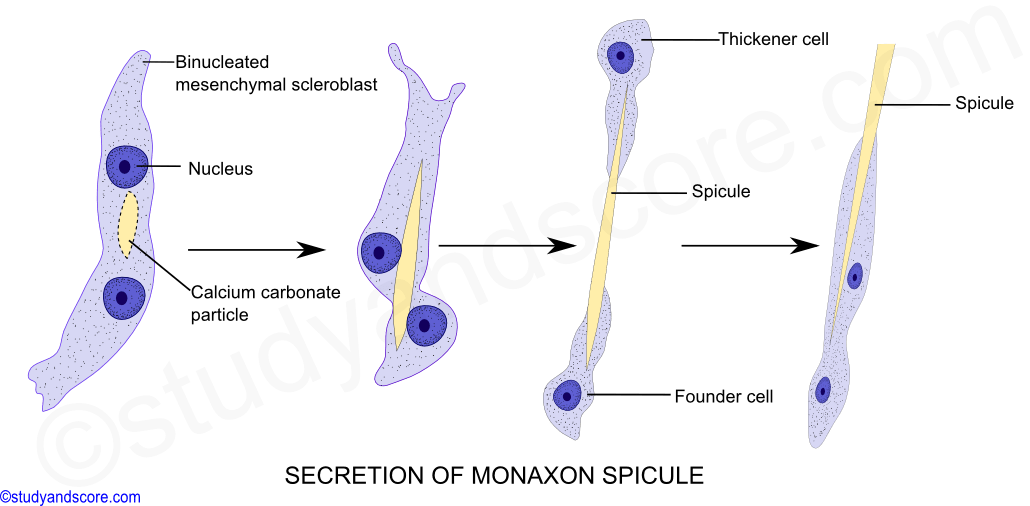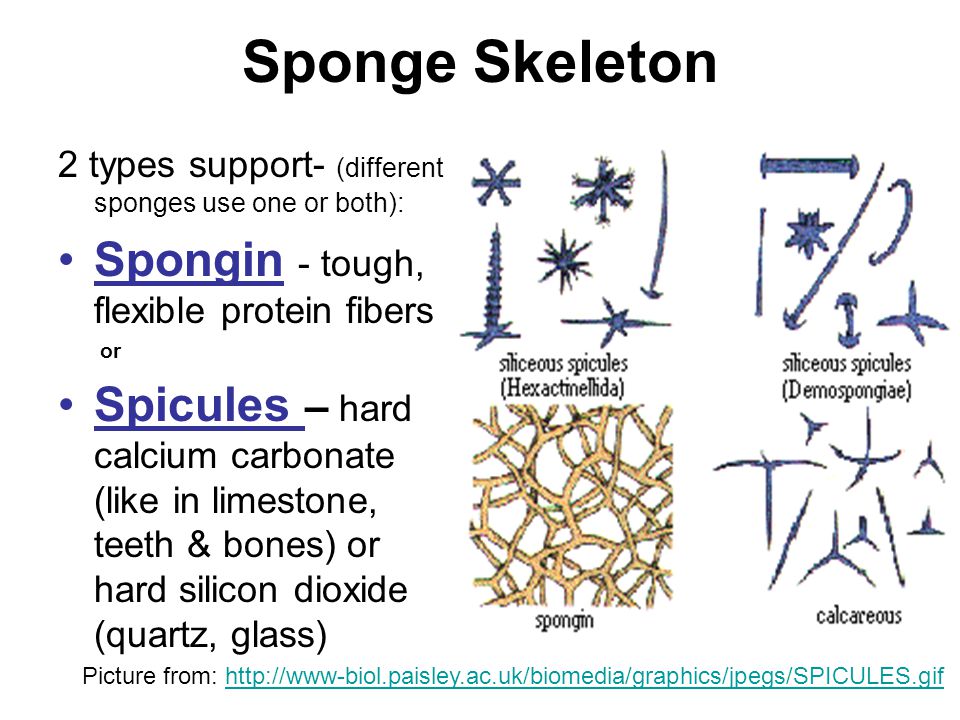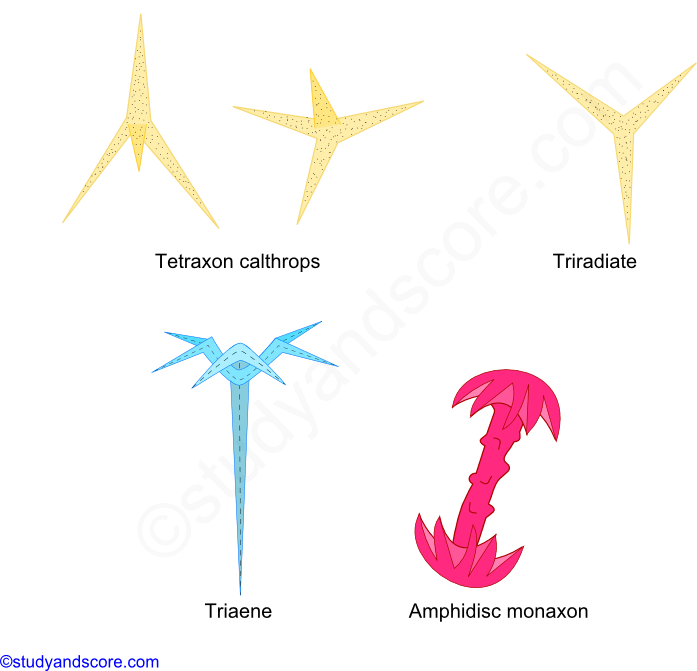Describe the Different Types of Sponge Skeletons
The base and inner tissue are light beige to buff and specimens growing in dark areas may be pale. These are the soft elastic sponges some of which are harvested for household and commercial use.

Phylum Porifera Skeleton Of Sponges Spongin Fibers And Spicules Study Score
The three classes of sponges are shown in Figure 4.

. The spicules constitute major part of skeletal system which are secreted by special mesenchymal cells called scleroblasts. The spongin comprises of fibres of spongin and they resemble silk in appearance. Answer to Describe the skeletons of each class of sponges.
The following points highlight the two main skeletal elements found in sponges. O Hydrostatic skeletons o Exoskeletons o Endoskeletons Hydrostatic Skeletons. The sponges possess an endoskeleton in the form calcareous spicules made up of calcium carbonate siliceous spicules made up of silica and spongin fibres.
Different skeletons have adapted to different methods of locomotion The various types of skeletons are an adaption to the environment in which the animal lives. Since there are no visceral organs in the skeleton of sponges their skeleton can not be categorised into external or internal category. Spongin fibres are composed of a silk-like scleroprotein.
In harder sponges the skeleton is made up of spiny spicules. They have different shapes. Taxonomists group sponges into three types based on the composition of their skeletons.
Many sponges have internal skeletons of spongin andor spicules skeletal-like fragments of calcium carbonate or silicon dioxide. These are proteinaceous secretion of the spongioblasts and form a network. Solutions for Chapter 12 Problem 8RQ.
The demosponges include 90 of all species of sponges. Describe the different types of sponge skeletons. These are the small spicules occurring interstitially.
Softer sponges spongin flexible protein fibers p. Some Demospongiae found mainly on the coral reefs possess a compact. An example of a primitive endoskeletal structure is the spicule of sponges.
The approximately 8550 living sponge species are scientifically classified in the phylum Porifera which is comprised of four distinct classes. The Demospongiae the most diverse containing 90 percent of all living sponges Hexactinellida the rare glass sponges Calcarea calcareous sponges and Homoscleromorpha the rarest and simplest class only recently recognized. Harder sponges spicules made of calcium carbonate or glasslike silica.
Learn about bones and skeletons and distinguish between endoskeletons exoskeletons and hydrostatic skeletons. The classification of Porifera is based chiefly on types of skeleton found in them. Glass sponges have spicules made of silica.
Calcarean sponges of order Pharetronida have skeletons formed by an amorphous mass of calcium carbonate with which few spicules are associated. Air land or water The different types of skeletons are. An endoskeleton consists of hard mineralized structures located within the soft tissue of organisms.
Here the endoskeleton is for support. 665 What type of nervous system do sponges have. Describe the skeletons of each class of sponges.
It has a dark brown to walnut brown or beige color. Sponges have a simple skeleton. Their skeletons are made of spicules consisting of fibers of the protein spongin the mineral silica or both.
About 80 percent of sponges belong to the class Demospongiae and have a skeleton made of spongin. Spicules are formed by carbonates of lime or silica in the form of needle like pieces. Skeletal structures of sponges are spicules and spongin fibres.
Describe the different types of sponge skeletons. The organisation of sponges has been grouped into three main types viz ascon type sycon type and leuconoid type due to simplicity in some forms and complexity in others. Those in the Demospongiae Lithistida form a heterogeneous group in which irregularly branched spicules desmas form a compact skeleton.
On the basis of number of axes and rays. In some species the spon-gin is reinforced with spicules of silica. Phylum Echinodermata consists of the various symmetrical marine animals like the star fish sea urchins etc.
The nature of the skeleton is an important characteristic in sponge taxonomy. So the correct answer is Endoskeleton. Chicken Liver Sponge has 2 different habits separated by color and habitat.
A Spit lest The spicules consist of microscopic needlelike spikes Spic les are formed by amoeboid cells. Phylum Porifera are sponge like animals and has almost 5000 species. They are made of calcium carbonate or silica.
These are larger spicules constituting main skeleton of sponge body. Softer sponges have an internal skeleton made of sponging a network of flexible protein fibers. The other 20 percent belong to the class Calcispongiae which have spicules made of calcium carbonate and the Hyalospongiae which have spicules made.
Although there are freshwater species the great majority are marine salt-water species ranging in habitat from. Calcareous sponges have spicules composed of calcium carbonate. Get solutions Get solutions Get solutions done loading Looking for the textbook.
The skeletons of each of the major poriferan groups are distinctive and have been used to reconstruct their evolutionary. As a whole poriferans have diverse skeletal elements including calcareous laminae organic filaments and siliceous and calcareous spicules. There are two types of skeleton in sponges.
All sponges are sessile aquatic animals meaning that they attach to an underwater surface and remain fixed in place ie do not travel. Spicules may occur in several forms like the simple rod form or in the form of forks anchors shovels stars plumes etc. The skeletal system has three types of skeletons that support the body.
Sponges like all animals possess some sort of a skeleton that gives their bodies shape. The bones of vertebrates are composed of tissues whereas sponges have no true tissues. Chicken Liver Sponge also known as Chondrilla Nucula.
The skeleton of sponges consists of microscopic calcareous or silicious spicules. The Skeletons of Sponges. Its skeleton is a compound of organic fibres a base of calcite and aragonite and spicules of silica.

Zoology For Students Skeleton Of Sponges Youtube

Chapter 33 Porifera Sponges Ppt Video Online Download

Phylum Porifera Skeleton Of Sponges Spongin Fibers And Spicules Study Score
0 Response to "Describe the Different Types of Sponge Skeletons"
Post a Comment